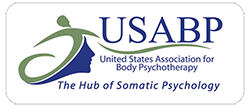Radix Institute
MembershipRadix Practitioner News
We are currently accepting registrations for membership in The Radix Institute for the year 2024. If you are a Certified Radix Teacher/Practitioner, Full Membership provides you with a listing on our “Find a Practitioner” page, and lets people know that you agree to abide by the Code of Ethics of The Radix Institute.
Practitioners who wish to participate in Radix Institute’s activities but who are no longer practicing may join as Associate Members.

The Radix Institute supports the work of the United States Association for BodyPsychotherapy. For information on the next USABP conference, go to www.usabp.org.
Pioneers of Neuroscience and Somatic Therapy

Trauma and Development
The right brain and the unconscious mind are more connected into the visceral body. As you know the body has been rediscovered in the last couple of decades. And that’s been an enormous change for psychology and psychiatry.
AS: Partly that. But also the developmental work on attachment theory and attachment trauma. Clearly, modern trauma theory, which did not really exist until around the late ‘90s, has also been one of the important transformations of the last two decades—the idea that “the body keeps the score,” as Bessel van der Kolk put it. But even beyond that, I would suggest it’s the re-discovery of the autonomic nervous system that is the major player here. It’s now an accepted principle that in order to understand the human experience it’s not just the voluntary behavior of the central nervous system, but also the involuntary behavior of the autonomic nervous system—mind and body. And that’s why much of my bodily-based attachment model involves the autonomic nervous system. The mother is literally a regulator of crescendos and de-crescendos of the baby’s developing autonomic nervous system.
These same bodily-based processes are also involved in the therapist’s right brain psychobiological attunement to and regulation of the patient’s emotional states. So the body has now embedded itself into the core of models of subjectivity—an embodied subjectivity which is not just an abstraction of the left brain, but right brain processes. The body is now seen as essential to right brain to right brain intersubjectivity. In my own work I’ve argued that this conceptual advance has impacted clinical models, such as somatic countertransference—the therapists’ own bodily reactions to patients’ conscious and especially unconscious communications. Also, there is the idea that a major function of the therapist is to regulate the patient’s autonomic arousal, a clinical concept that has challenged the older idea of neutrality, and that expands the previous concept of containment. This perspective attends more to right brain unconscious process than left brain conscious content. Once again, these scientific advances have transformed our clinical models.
Repressed traumatic development
Trauma theory emphasizes working with the deadening of affective consciousness by this other bodily-based survival defense, dissociation. Clinicians are learning to differentiate the two and recognize the latter.
But, yes, the idea about disruptions and repairs came out of the developmental data and was incorporated into my modern attachment theory. My writings emphasize that rupture and repair, both in the developmental and psychotherapeutic contexts, involve important opportunities for interactive regulation of dysregulated affective states.
At the most fundamental level I’m interested in the mechanisms of change, especially in the early developing right brain self system. To use an earlier language, what I’m exploring is how the object relational sequences between the mother and the infant shape emerging psychic structure. In more modern terms these are investigations of interpersonal neurobiology. An interpersonal neurobiology of human development enables us to understand that the structure and function of the mind and brain are shaped by experiences, especially those involving emotional relationships, and to understand how brains align their neural activities in social interactions.
The tie in from my developmental work to my clinical work is that the same right brain to right brain social emotional processes that are setting up between the mother and the infant later play out in the therapeutic alliance. The model links the right brain growth in early development with later changes in the social/emotional context. And as you pointed out rupture and repair are potential contexts of emotional growth. So I’ve paid attention to the work of other developmental psychoanalytic researchers like Beatrice Beebe and Ed Tronick and Karlen Lyons-Ruth, who are also studying ruptures and repairs.
In my most recent writings I’ve focused on the essential role of these repairs in re-enactments of attachment trauma, which really is at the heart of the therapeutic change mechanism. I’m describing how both patient and therapist co-construct both the rupture and the repair, and that these ruptures are not technical mistakes, but literally—
Paths of healing
AS: Beautifully put. Enactments represent communications of previous ruptures that triggered negative affects so intense and so painful that they were dissociated and banished from consciousness. As the therapy progresses and the attachment bond in the therapeutic alliance strengthens, there is enough safety for the patient to dis-assemble the dissociative defenses and let the affects come online more frequently. And then, what has been buried and packed down underneath dissociation surges into bodily awareness in the presence of a regulating other, now offering a possibility of interactive repair.
Jung, who studied dissociation, described how the enduring emotional impact of childhood trauma “remains hidden all along from the patient, so that not reaching consciousness, the emotion never wears itself out, it is never used up.” He also stated the trauma may suddenly return: “it forces itself tyrannically upon the conscious mind. The explosion of affect is a complete invasion of the individual. It pounces upon him like an enemy or a wild animal.”
In my model of “relational trauma” I’ve suggested that it’s not just mis-attunements that lead to the traumatic predisposition. It’s also the lack of the repair, and that repair and interactive regulation requires a very personal, authentic response on the part of the therapist. Attachment trauma was originally relational, and so the healing must be relational, a mutual process. In Sullivan’s words, the therapist is not neutral and detached, but a “participant observer.”
Bio
His contributions appear in multiple disciplines, including developmental neuroscience, psychiatry, psychoanalysis, developmental psychology, attachment theory, trauma studies, behavioral biology, clinical psychology, and clinical social work. His groundbreaking integration of neuroscience with attachment theory has led to his description as “the American Bowlby,” with emotional development as “the world’s leading authority on how our right hemisphere regulates emotion and processes our sense of self,” and with psychoanalysis as “the world’s leading expert in neuropsychoanalysis.”
The American Psychoanalytic Association has described Dr. Schore as “a monumental figure in psychoanalytic and neuropsychoanalytic studies.”
Radix Institute Inquiry: Request for Information
Radix Training Inquiry - Call 310-570-2439 or Fill Out Form
Non-Discrimination Policy
The Radix® Institute does not and shall not discriminate on the basis of race, color, religion (creed), gender, gender expression, age, national origin (ancestry), disability, marital status, sexual orientation, or military status, in any of its activities or operations. We are committed to providing an inclusive and welcoming environment for all members of our Board, staff, clients, volunteers, subcontractors, vendors, and clients.

